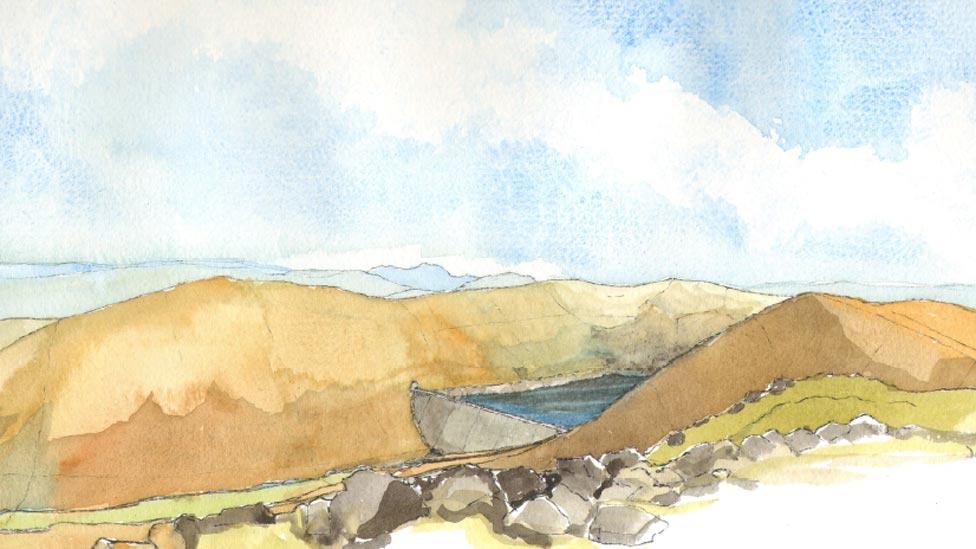Turbines stuck between seabed rock and hard costs
- Published

RWE/Npower recently abandoned plans for a huge array off the coast of Devon
Britain is the world leader in planning for offshore wind power.
However, it's far from being a world leader in developing it, and even less so in manufacturing for it.
The announcement by Scottish Power that it's abandoning plans to develop a vast wind turbine array off the Isle of Tiree is the third blow in recent weeks.
Yesterday, Centrica bailed out of a stake it had in the planned Race Bank array off the east coast of England, selling it to Dong Energy.
And late last month, RWE/Npower abandoned plans to build another very large array off the coast of Devon and near the Isle of Lundy.
Amid this, the UK government last week changed the level of subsidy that offshore wind can expect. It tilted the playing field slightly against onshore wind, and in favour of offshore, with a higher 'strike price', or guaranteed floor price at which developers can make their investment decisions.
This was apparently without any advance discussion with the industry, or any of the evidence base it had previously and carefully worked through.
The government's move should have helped offshore wind. And Scottish Power is careful not to blame the government for the problems that have led to its abandonment of the Argyll Array.
Shark infested
It is blaming technical difficulties, costs and environmental concerns. There's a lot of volcanic rock that has to be drilled through. The sea swell is a bigger challenge than previously calculated. The cost at which offshore wind can be developed is not falling as fast as anticipated.
And there are a lot more basking sharks off Tiree than anyone had previously realised, before you start to count the hit rate for great northern divers, corncrakes and the Greenland white-fronted goose.

A study found there were a lot more basking sharks off Tiree than previously thought
That's not to say the basking sharks can assume they've won this battle for keeps. If the costs fall, as happens with most such technologies and helped by the experience of piling turbines into less hard rock in other places, then the Argyll Array could be looked at in another 15 years.
Scottish Power continues to plan for wind arrays off the east coast of England. And SSE is among those planning for big wind farms off the east of Scotland.
But because it's easier to put your wind turbines in the shallower waters off England, as well as being closer to customers, Scotland still has hardly any offshore wind. There's merely a trial turbine in the Moray Firth, a gigantic trial turbine a few metres off the quayside at Methil in Fife, and a share of an array in the Solway Firth.
While costs stay higher than expected, we continue to await the commitment from manufacturers to start building turbines in Scotland, and in north-east England. That's where the economic benefit can come from, and it remains a concern for the industry that until that stage, much of the economic benefit goes to foreign suppliers.
Hydro gets pumped up
A happier episode in renewable energy is hydro power being given a big boost, with planning consent for a big new pumped storage project in Lochaber. Coire Glass, near Spean Bridge, will cost £800m - if SSE decides to invest in it, which it probably won't do until 2015.
The extent of pumped storage is not nearly as developed as in Norway, but in Foyers, near Loch Ness, and Cruachan, near Oban, there are already the turbines to push water uphill, using excess wind energy at times of low demand.
Come the morning cuppa, and a rise in electricity demand, the water then provides instant and very large amounts of electricity at the turn of a large valve.
The most powerful such UK project is in Wales, which can provide 2,000 megawatts of power for a short time. SSE's Foyers plant can provide 300 megawatts for up to 16 hours.
The attraction of Coire Glas is that it can provide 600 megawatts of power, and it has a big enough reservoir to continue doing so for days.
We probably haven't seen the last of these big pump storage projects, as they mix well with wind power. Indeed, one option is to build a connector with Norway to power its hydro pump storage overnight.
But it's not clear what the funding support is for pumped storage hydro. For regulatory purposes, it doesn't count as a renewable source. And on grid pricing, it draws a lot of power from the grid, at points of low demand. That's the whole point of it, and grid charging doesn't yet take account of that. So there is no mechanism in place to encourage development of the technology.
That's why SSE is still to doing the maths on what level of support it should expect from the UK government if it's to make its Coire Glas investment stack up.
- Published13 December 2013

- Published13 December 2013
